FRUITFUL THOUGHTS
Watch for Road Blocks
If you’re considering growing fruits, good idea. You’re probably dreaming about, in a few years, being able to reach for a ripe red apple, a peach, a cherry, or a plum from a fruit laden branch. To a large degree depending on where you garden, you could be paving the way for disappointment. Insect and disease pests, and specific pruning needs, are potential road blocks for many of the more common fruits. 
Yet, luscious fruits plucked from a backyard plants are such a delicacy. What else but a fruit could have tempted Adam and Eve? Fortunately, many fruits need only a minimum amount of care. What follows are easy-to-grow fruit plants, grouped into three categories, from the very easiest to the “hardest easiest.”
Easiest Peasiest
The first category includes plants that you merely set in the ground, then come back in a couple of years for the first of many years of harvest. Well, almost nothing else to do. You may recognize in this category some plants commonly grown as ornamentals. Their flavorful fruits have too often been overlooked.

Highbush cranberry
Quite a few bushes fall into this category, including elderberry, beach plum, highbush cranberry, and nannyberry viburnum. All roses bear edible fruits if their flowers are not cut. Amongst rose species, Rosa rugosa (considered invasive in certain regions)and R. pomifera bear largest fruits, called hips, with sizes somewhere between that of marbles and golf balls.
Another sometimes-planted ornamental, oft-overlooked for its fruit, is Nanking cherry. Pinkish-white blossoms adorn the bare reddish stems in very early spring and the small, scarlet, delectable cherries ripen in early summer.  One of my favorite plants and fruit, Nanking cherries also are quick to come into bearing.
One of my favorite plants and fruit, Nanking cherries also are quick to come into bearing.
Juneberry (also called serviceberry, shadbush, shadblow, and amelanchier) species are either bushes or small trees. The plants are clouds of white blossoms in the spring and then bear small, blue fruits resembling blueberries but only in appearance. Taste the fruit and you’ll find it has the sweet, rich flavor of sweet cherry, with a hint of almond aftertaste. Juneberry is a relative of apple and shares some of its pest problems. Despite my love of the fruits, my site is poor for fruit growing so I can’t grow juneberries here. But I can harvest them from better situated ornamental plantings nearby.
Cornelian cherry is another small tree, a dogwood relative whose creamy yellow blossoms welcome in the first days of spring and then are followed in summer by scarlet “cherries.” The fruits are tart but tasty to many people (60 percent of tasters by my seat-of-the-pants surveys), and good for tarts, jams, and sorbets.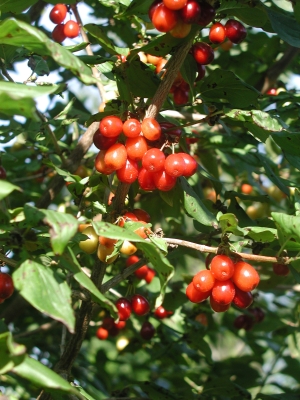 Other tree fruits in this easiest-to-grow category include mulberries, pawpaws, and American persimmons. Almost everyone is familiar with mulberry, and the only caution here is not to plant it near walkways where the fruits will be carried on the bottoms of shoes to carpets indoors.
Other tree fruits in this easiest-to-grow category include mulberries, pawpaws, and American persimmons. Almost everyone is familiar with mulberry, and the only caution here is not to plant it near walkways where the fruits will be carried on the bottoms of shoes to carpets indoors.
Pawpaw fruits are custardy, with banana-like flavor. Here is a plant with many tropical aspirations: large, lush green leaves; fruit developing in clusters like bananas; and kinship with the mostly tropical custard apple family.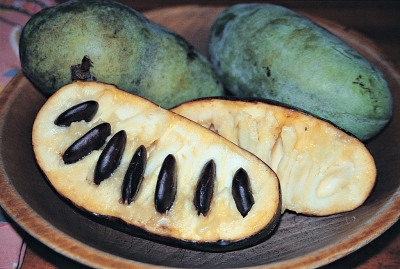
If I were to describe a persimmon fruit, I’d ask you to imagine a dried apricot that’s been soaked in water, dipped in honey, and given a dash of spice. This tree is pretty all summer long and especially in fall when the persimmon orange fruits poke out from behind the leaves.

Persimmon fruit perched on branch; makes a pretty picture but they don’t grow this way
Not your average grocery store fare, persimmon or pawpaw, but both are very easy to grow. Selected varieties of persimmons (I grow Szukis and Mohler) and pawpaws have been developed that bear better fruit than seedling trees.
Pruning, but Easy
My second category of easy-to-grow fruits includes those that require planting (of course), plus annual pruning. Plantings of bramble fruits — red, yellow, and black raspberries, and blackberries, — too often become unmanageable, unproductive tangles of prickles or thorns. This condition is easily avoided with annual pruning which, in contrast to the melding of art and science required for apple pruning, is a no-brainer.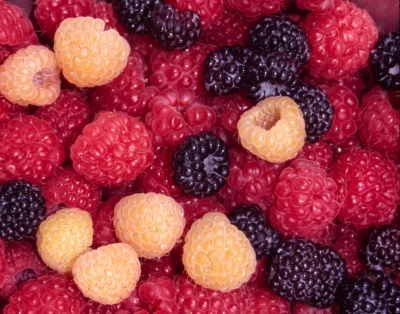
It’s hard to imagine that strawberry plants could eventually shade each other into unproductivity. But they do, and hence need annual pruning, in the form of thinning out of surplus plants.
Gooseberries and currants also are much more pleasant to harvest, in addition to being more productive, when annually pruned.
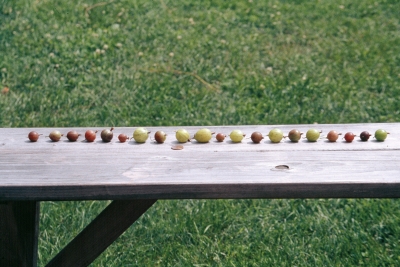
Many varieties of gooseberry
Hardy kiwi is a cold-hardy, fuzzless relative of the grocery-store kiwi, green, grape-sized, and with a similar, but sweeter and richer, flavor. Just pop them in your mouth, smooth skin and all, like grapes. Two species are the ones usually grown for their fruits. You can get by with little pruning on the more sedate growing, midsummer bearing Actinidia kolomikta. A. arguta, the other species will send out many 10-foot-long stems; it’s fruit ripen late summer or early fall — and you have to prune it or it will tear down whatever arbor or fence you’re letting it climb on.
(Hardy kiwi has been accused of being an invasive plant. After decades of growing this plant and speaking to, and looking at plantings of, others who grow it, I strongly disagree with this accusation.)
Perhaps a Pest, Perhaps Not
My third category includes fruits that require, in addition to planting and annual pruning, a minimum amount of pest control. Such fruits still are easy-to-grow. This category includes grapes, pears, and blueberries. In a given season, pests may or may not be a problem, but be prepared to control them if they arise: a couple of diseases on grapes, perhaps one or two insects or diseases on pears, and birds on blueberries.
Varieties amongst fruits in this latter category vary in their susceptibility to pests. Magness, Moonglow, Maxine, and Seckel, for instance, are pear varieties resistant to fireblight. I grow Magness, Seckel, and many other pear varieties and am happy to report no pest problems worth addressing in most seasons. Blackrot of grapes is less serious on grape varieties such as Delaware, Elvira, and Fredonia. I grow Brianna, Somerset Seedless, Alpenglow, Wapanuka, and Bluebell grape and keep pests at bay by enclosing a number of bunches in bakery bags.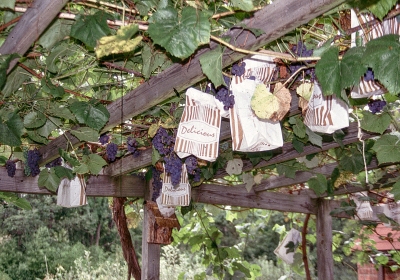
Birds are the main threat to blueberries, although they do leave my lowbush blueberry fruits more or less alone. In addition to lowbush blueberries, I grow highbush blueberries, which birds love. So my blueberries grow in my Blueberry Temple which has permanent sides of birdproof netting, with additional netting draped over the top when fruits are ripening.
So my blueberries grow in my Blueberry Temple which has permanent sides of birdproof netting, with additional netting draped over the top when fruits are ripening. 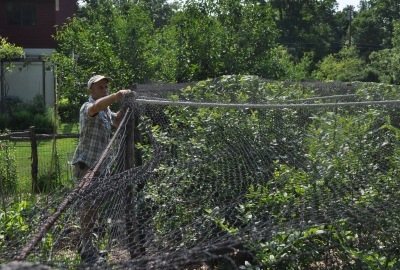 Problem solved.
Problem solved.
Now is the time to plan for fruit plants, not grow them. So do make these plans, but plan according to the effort you are willing to invest in caring for the plants.
(I cover the cultivation, adaptability, and potential pests of most of these fruits in my book Landscaping with Fruit.)


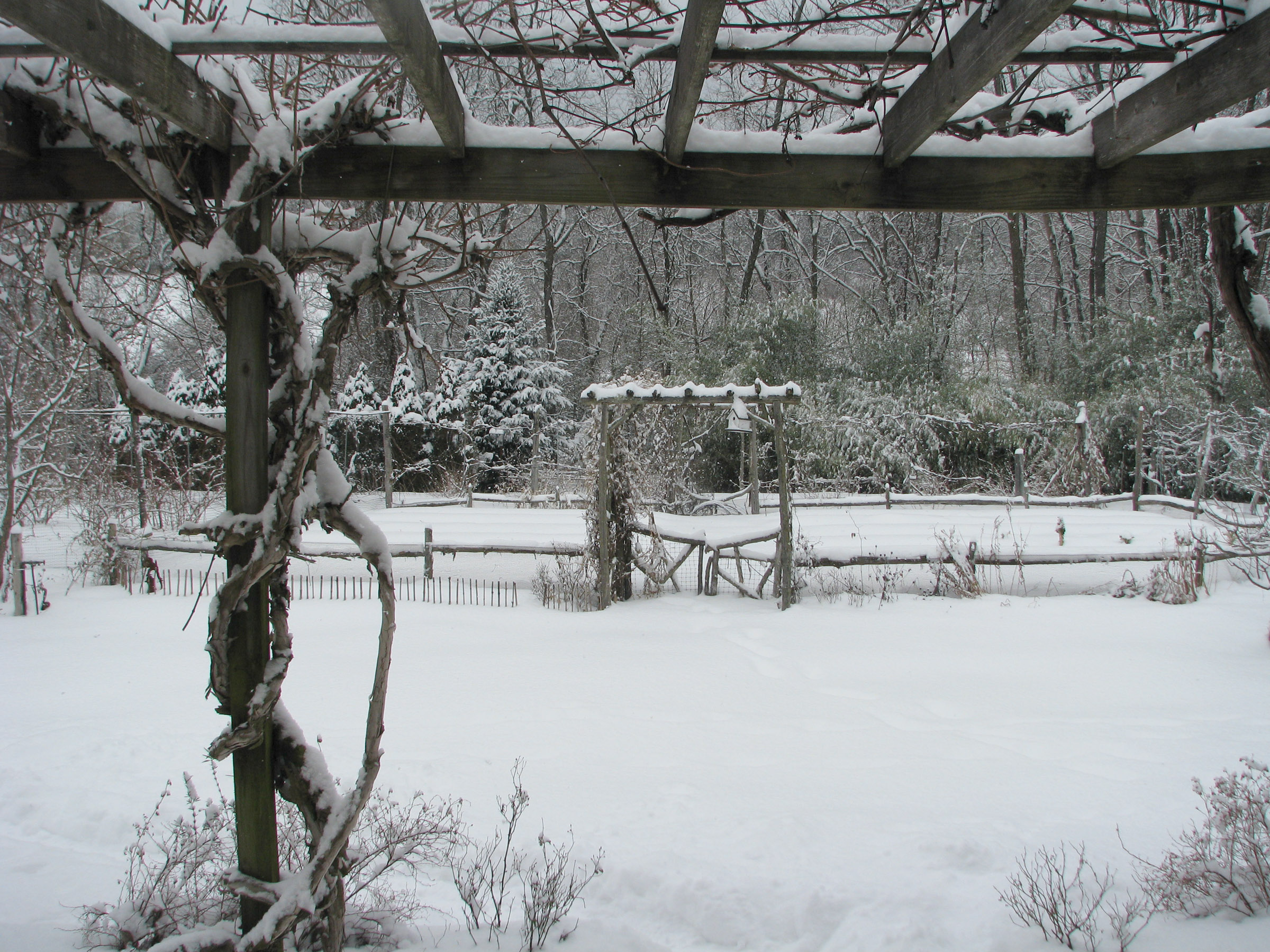
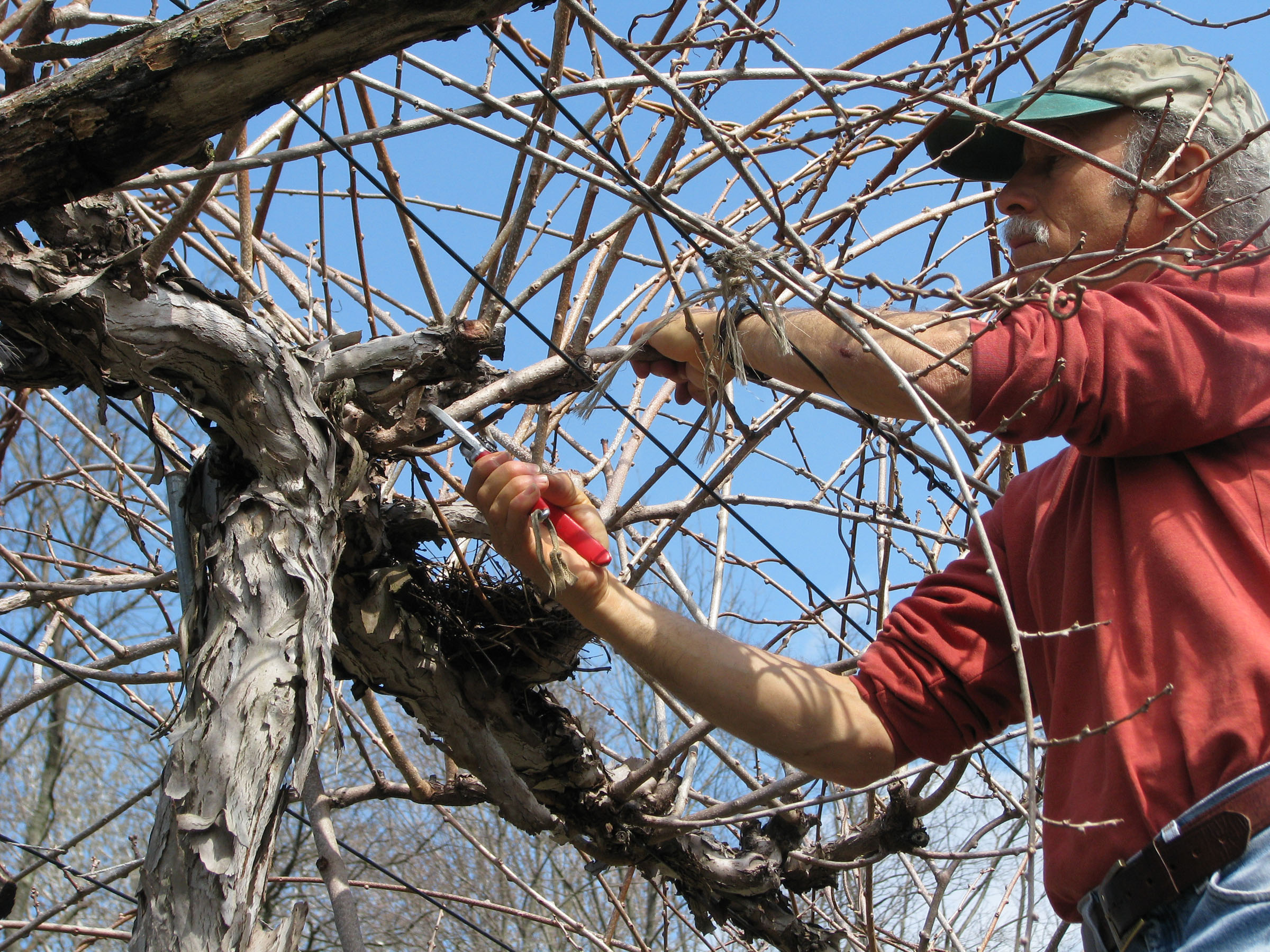
I’ve come to appreciate blackcurrants more and more. It’s no surprise that you can’t (in New Zealand) generally buy them in the stores fresh, given how long it takes to harvest, but I enjoy the time spent outside and often come away with up to 20 kg I have to give away which results in a dividend of jams and puddings.
Gooseberries are another of my favourites. One of my bushes sourced long ago from someone who found it at an old gold field yielded 7 kilograms just by itself. I was given two worchesterberry plants by someone else and the vigor and thorns put me on the verge of tearing them out. I lazily let the fruit sit and ripen this year until I got around to picking them and they were well worth it – like a sweeter small gooseberry.
Everything has to be netted here and depending on the fruit sometimes well before ripening or I’d get nothing! The sheep chewed through the netting on one thorny gooseberry plant from a neighbouring field this year and the birds got in and stole the lot.
I’m luck. No need to net gooseberries or currants, not even the red ones.
Inspiring, as always, thanks!
Interesting to see you’re going w/the bakery bags to protect fruit bunches. We did try the organza bags, they’re a mess to clean. Have you decided against those?
Birds see the grapes and peck at the organza bags, damaging the bags and the grapes.
Great article! I did plant a pair of high bush cranberries and they grew well. But apparently Viburnums can get COVERED with tiny worms which utterly destroy the leaves leaving a very unsightly mess. Any thoughts on saving my bushes? I have had very little fruit/flowers on then since they are always stressed from the worms.
The pest is viburnum leaf beetle (Pyrrhalta viburni). When the shrub is leafless, between late fall and early spring, take a pair of pruning shears and inspect all the stem tips, where they lay there eggs, removing and destroying those that bear the characteristic straight row of brown bumps, very literally nipping the infestation in the bud. Spraying with an insecticidal soap and pyrethrin will help, but it works best at the beginning of the season, when larvae are small.
How about a newsletter on where to get all these plants? A review of the catalogs you like and who carries what exotic items.
For exotic fruit plants, raintrenursery.com
For high quality common fruits, cumminsnursery.com
For specialist in blueberries, hartmannsplantcompany.com
For berry specialist, noursefarms.com
The black currants from Rain tree Nursery are excellent.
I planted Hills Kiev and Belruskaja. Both are productive in short order and so delicious.
If one does not have a lot of space, is it possible to grow 2 hardy Kiwi plants side by side up and onto a T-trellis with the cordons going in one direction only? How long should the trellis be in that case?
Thank you.
Yes, it’s possible if you grow Actinidia kilomikta male and female (sometimes sold as Arctic Kiwi). Right after blossoming the male can be pruned back rather severely. 15 feet of trellis would probably be ok.
Thank you. Should I allow two cordons on the female plant, or just one, which will grow up to 15 ft. long.
Thank you.
Thank you for your post! Would it be possible to grow hardy Kiwi plants on a sturdy arbor (instead of a T-trellis), since the fruit of hardy kiwi plants stores up to six months, and how can I prevent the posts of the arbor from rotting in the ground. Thank you.
Yes, they could be grown on an arbor. The fruit keeps well, but not six months! Prevent rot by using rot resistant wood for posts.
Curious of your favorite raspberry varieties. I’m in midcoast Maine 5b might be 6 by the new zone charts. Thx for all your knowledge shared.
Fallgold, Canby. Definitely NOT Heritage.
I am in zone 5b, and I have some berry bushes overwintering in 1-gallon containers in a protected area, albeit no sun, on the north side of my house. I am not sure when would be a good time for planting these, because of the huge temperature differences between days, currently in the fifties and even sixties (!), and nights, currently twenties or thirties. Should I move them to a frost protected, semi-sunny location for now? Thank you.
Assuming the plants are still dormant, you could plant them out now.
I have a large lonicera, which I am planning to remove, in the southeast corner of my yard (zone 5b). Since this spot gets full sun all day, I am planning to grow 2 Nanking cherries and 4 grape vines in this corner. Is there a creative way to design this corner, perhaps adding other plants also?
My second question would be: I would like to grow raspberries in unused spaces in my yard and was wondering if it is possible to use tomato plant cages as a trellis for single plants, or if there are other ways to trellis single plants. Thank you.
The design is up to you, especially because there’s more in the scene than just three plants.
Raspberries don’t grow as single plants. They spread underground and send up new shoots. Containing a plant in a tomato cage, if it was possible, would give you very few berries.
Thank you for your reply! Could you please give examples of a tree or other shrubs/any plants, all on the smallish side, which would do well with Nanking Cherries and grapes?
I am sorry for the misunderstanding regarding the raspberries. I meant to ask if it was possible to attach the different stems of a trailing raspberry plant to the outside of a tomato cage, and I assumed that the plants don’t need to grow in pairs for them to have fruits. Could you please comment? Thank you.
Medlar, beach plama
Thank you for this very interesting article. You wrote that the Kiwi variety Actinidia kolomikta is midsummer bearing, and Actinidia arguta ripens late summer or early fall. Could you please let us know how many weeks or months you can store both varieties? I assume in summer the Kiwis need to be stored in the fridge. Is this also the case for the variety which ripens early fall or is a cool room sufficient? Thank you!
The cooler the temperature (but above 32 degrees F) the longer the storage. Also, dead ripe fruit won’t keep as long as mature, but not ripe, fruit. On average, under the best storage condition, the berries should keep a few weeks.
Thank you for this information! I have noticed a video on your website on how to prune a kiwi plant. Could you please tell us which variety of kiwi plant you are pruning in this video, whether this is one plant only, and how old the plant was at the time you recorded the video? Thank you.
The variety is Anna, more formally knows as Annanasnaya, about 25 years old. That kiwi is only one of a few different varieties I grow (as well as kolomikta species) of hardy kiwifruit.
Great article. Which birdproof netting do you use for your blueberry enclosure? I’ve had difficulty finding openings large enough for bees, but small enough to restrict birds. Also heavy enough to stretch without tearing so that a bird can’t get caught in the net. Thank you.